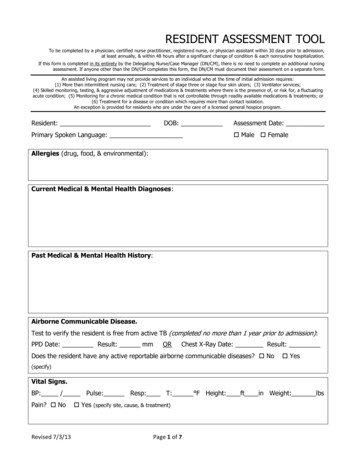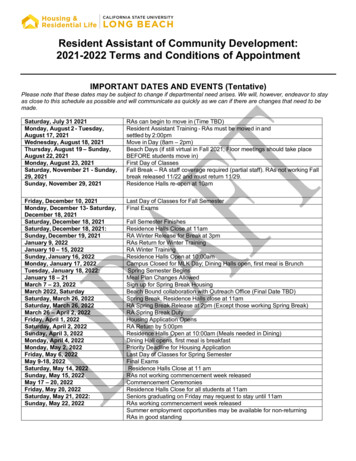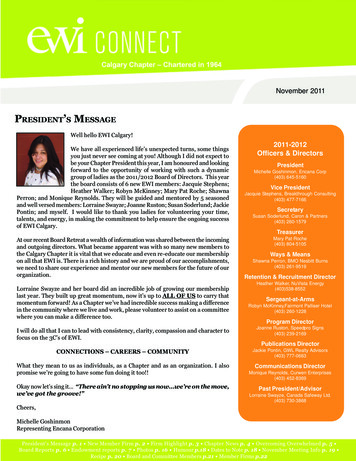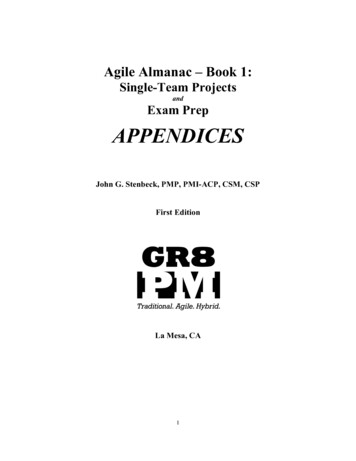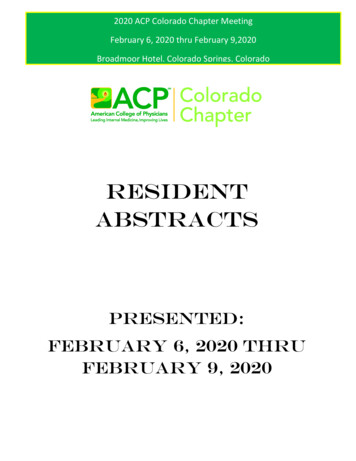
Transcription
2020 ACP Colorado Chapter MeetingFebruary 6, 2020 thru February 9,2020Broadmoor Hotel, Colorado Springs, ColoradoBroadmoor Hotel, ColoradoResidentAbstractsPresented:February 6, 2020 thruFebruary 9, 2020
2020 ACP Colorado Chapter Meeting – February 6, 2020 thru February 9, 2020– Broadmoor Hotel – Colorado Springs, ColoradoName: Evan Cherry, MDPresentation Type: Oral PresentationResidency Program: University of Colorado School of MedicineAdditional Authors: Juan Lessing, MD, FACPAbstract Title: Missed Connection: Imperfect Role of Imaging in Diagnosisof Esophagopleural FistulaAbstract Information:A 37 yo man presented with sudden food impaction. After endoscopic disimpaction, CT chestwith oral contrast revealed perforation at the GE junction, extraluminal contrast in the Leftparaesophageal space, and pneumomediastinum. After emergent endoscopic esophagealstenting, repeat CT chest demonstrated an unexplained Left pleural effusion withoutcontrast enhancement, for which a percutaneous thoracostomy tube was placed. Plainesophagram did not demonstrate stent leak.Medical management consisted of strict NPO, intravenous fluids, IV PPI, broad-spectrumantibiotics, and thoracostomy drainage with enzymatic disruption of loculated fluid. After 5days, repeat plain esophagram was negative for esophagopleural fistula. CT chestdemonstrated decreased Left effusion volume, but interval development ofpneumohydrothorax. Video-Assisted Thoracic Surgery decortication was converted to openthoracotomy due to discovery of vegetable matter in the pleural space. His post-operativerecovery was uneventful and the esophageal stent was endoscopically removed one monthafter thoracostomy. He has returned to work and travelling with his wife.Discussion:This case highlights limitations of advanced imaging and implications for nonsurgicalmanagement of esophageal perforation.Esophageal rupture is a surgical emergency, though nonoperative management is emergingas a viable alternative to high-morbidity and high-mortality surgical interventions. Initialmanagement includes NPO, hemodynamic monitoring, surgical evacuation of extramediastinal leaks, esophageal stenting, and broad-spectrum antibiotics. (PMID: 16427833,PMID: 25791945)Chest CT is the preferred imaging modality for stratifying pleural space infections, thoughesophagopleural fistulas may not be apparent on imaging, especially within the first 24hours, and can occur irrespective of radiographic mediastinitis (PMID: 3490162, PMID:20133295, PMID: 28575240). An esophagopleural fistula was not demonstrated on theinitial CT prior to esophageal stenting, nor in subsequent CTs and esophagrams. However,vegetable discovered in the pleural space during VATS indicated definite transesophagealmigration of food into the pleural space. The esophageal rupture was not contained to themediastinum and could not be successfully managed nonoperatively.
Understanding the limitations of radiology in diagnosing an esophagopleural fistula isessential to considering this diagnosis. Diagnostic performance of CT scan for esophagealperforation is imperfect for detecting leakage of contrast into pleural space (Sensitivity55.6%, Specificity 96.3%, PPV 71%, NPV 92.9%, LR 15, -LR 0.46) or detecting an overesophageal fistula (Sensitivity 11.1%, Specificity 100%, PPV 100%, NPV 87.1%, LR N/A, LR 0.89) (PMID: 24748526). In retrospect, a higher clinical suspicion was warranted foresophagopleural fistula as a cause for the effusion. Surgical intervention was delayedbecause of negative imaging. Meanwhile, the patient clinically deteriorated. Eventualdevelopment of hydropneumothorax necessitated decortication. His complete recoveryvalidated surgical intervention for pleural effusion with distal esophageal perforation.
2020 ACP Colorado Chapter Meeting – February 6, 2020 thru February 9, 2020– Broadmoor Hotel – Colorado Springs, ColoradoName: Rachel Chung, DOPresentation Type: Oral PresentationResidency Program: Sky Ridge Medical CenterAdditional Authors: P. Jenkins, P. Judiscak, S. Moreland, D. ScherbakAbstract Title: Inappropriate antibiotic use in the emergency department and the2016 Surviving Sepsis Campaign GuidelinesAbstract Information:Introduction:The IDSA did not endorse the 2016 Surviving Sepsis Campaign guidelines. One of theirconcerns was that the one hour window from the recognition of sepsis to antibiotic therapymight lead to inappropriate antibiotic use. The aim of this study is to test the hypothesisthat the 2016 Surviving Sepsis Guidelines have led to an increase in inappropriateantibiotics prescribed in the ER.Materials and Methods:We conducted a retrospective cohort study of all inpatients aged 18 to 89 years of ageadmitted to Sky Ridge Medical Center between June 2016- January 2017 and January 2017April 2019. We performed a power calculation using a G- power for Fischer’s exact test,assuming power of 0.8, alpha of .05 and a two tailed test. In order to find a minimum 15%statistically significant difference in antibiotic prescribing between groups, we needed 2,562patients. Patients were included if they fulfilled HCA accepted SIRS criteria for sepsis andreceived an antibiotic on day 0. Patients were excluded if they met criteria for septic shock,received a vasopressor, or were diagnosed with respiratory failure. The cohort was split intogroup A, seen in the ER prior to the publication of Surviving Sepsis Campaign 2016Guidelines (June 2016-Janurary 2017), and group B, seen after the guideline (January 2017April 2019). An antibiotic was appropriate if SIRS criteria were fulfilled and there was anICD-10 code of an infection linked to the visit. If an antibiotic was given without a diagnosisof infection, it was inappropriate. Fisher’s Exact test was used for data analysis.Results:Of Group A (N 1050), 25.42% of patients met SIRS criteria for sepsis but received aninappropriate antibiotic and 9.6% did not meet SIRS criteria and received an inappropriateantibiotic. Of group B (N 1512), 27.58% of patients met SIRS criteria and received aninappropriate antibiotic, and 8.0% did not meet SIRS criteria and received an inappropriateantibiotic. Fischer’s exact test of the difference between the two groups fulfilling SIRScriteria was not statistically significant (p 0.54). Fischer’s exact test of the differencebetween groups not fulfilling SIRS criteria was not statistically significant (p 0.56).Conclusion:These results provide evidence that the 2016 Surviving Sepsis Campaign guidelines did notsignificantly affect antibiotic practices in the ER. We found that 25-27% of patients received
inappropriate antibiotics in the ER. These findings are lower than previous studies ofantibiotic prescription practices in the ER. The discrepancy is likely due to our loosedefinition of appropriate antibiotics. We plan to perform a much larger study with 130,000patients over a larger time-frame and across multiple hospitals to improve statistical power.
2020 ACP Colorado Chapter Meeting – February 6, 2020 thru February 9, 2020– Broadmoor Hotel – Colorado Springs, ColoradoName: William Grigg,Presentation Type: Oral PresentationResidency Program: Parkview Medical CenterAdditional Authors: Dhamista Chaudhary, MD, Bhavani Suryadevara, MDAbstract Title: What to do when WATCHMAN Fails?Abstract Information:Introduction:For patients that are not candidates for long-term blood thinners until recently there has beenlittle choice but risk vs reward discussion. With the introduction of WATCHMAN this no longerjust a discussion but now a procedure. The problem arises when failure occurs, what are the nextsteps when a patient “breaks through” and WATCHMAN fails? This case highlights an 88-yearold male with a history of Atrial Fibrillation (Afib) s/p WATCHMAN device placement in the fall2018; was on Xarelto for 2 years prior to watchman device placement. Previously, a TEE done45 days post watchman device placement in Nebraska had shown a leak, so patient wascontinued on Eliquis for 6 months post implantation. Repeat TEE done after 6 months ofimplantation showed a well-functioning device so anticoagulation was stopped.Case Description:He presented to the hospital on 4/19/19 with focal neurological deficits characterized by RUEweakness, dysarthria and difficulty with comprehension. He was given tPA and transferred toICU. His symptoms eventually resolved completely. Work-up in the form of CT-Head did notshow any acute intracranial findings, MRI-Brain did not show any infarct and head and neck CTAwere unremarkable. Cardiology was consulted to give recommendations on anticoagulation asthe patient had a TIA despite watchman device. Cardiology started the patient on Eliquis,stopped the Plavix, continued ASA and performed TEE to reassess the device: TEE showed adevice leak of 0.68 cm despite endothelialization of the device. It was likely that the device sizewas chosen wrong and it’s conceivable that there was a clot in the left atrial appendage that wentaround the watchman device causing TIA. Cardiology recommended continuing Eliquis lifelongfor secondary prevention of TIA/stroke.Discussion:This case illustrates the potential for continued anticoagulation and possible need for continuedimaging in patients with WATCHMAN long after the recommended 45 days post procedure. Thiscase also high lights the need for further investigation and the need for guidelines on what to dowhen a patient fails WATCHMAN and what and what the anticoagulation of choice should be.
2020 ACP Colorado Chapter Meeting – February 6, 2020 thru February 9, 2020– Broadmoor Hotel – Colorado Springs, ColoradoName: Jason John, MDPresentation Type: Oral PresentationResidency Program: University of Colorado Medical SchoolAdditional Authors: Bill Quach, MD, Erin Bredenberg, MDAbstract Title: More Than a FlukeAbstract Information:A 60-year-old African woman presented to the emergency department with three days ofabdominal pain, nausea, and vomiting. She had recently returned from a ten-month tripthrough rural Ethiopia where she consumed unpasteurized milk and well water withexposure to goats, cats, and livestock. Her medical history was otherwise unremarkable.On exam, she was tachycardic (110 bpm), hypotensive (53/34 mm Hg), and afebrile. Herexam was also notable for midline abdominal tenderness. Laboratory findings were notablefor white blood cell count of 22 x 109/L without eosinophils, hemoglobin of 13.3 g/dL,platelet count of 35 x 109/L, total bilirubin of 1.4 mg/dL, direct bilirubin of 0.6 mg/dL,alkaline phosphatase of 143 U/L, aspartate aminotransferase of 38 U/L, alanineaminotransferase of 40 U/L, and lactate of 8.3 mmol/L. Blood cultures on admission grewKlebsiella pneumoniae. Non-contrast CT of the abdomen was notable for hepatomegaly withcavitary lesions in the left lobe of the liver consistent with abscesses, pneumobilia withbiliary ductal dilation, and a hydropic gallbladder. Percutaneous drainage of the gallbladderand left liver abscess was performed with frank pus aspirated from the abscess. MRCPrevealed tubular filling defects in the dilated extrahepatic biliary ducts.ERCP revealed a choledochoduodenal fistula with a foreign body versus parasite visible inthe common bile duct. Balloon sweep of the bile duct yielded sludge followed by passage of a13-inch roundworm. The worm was retrieved and sent to infectious disease, where it wasidentified as Ascaris lumbricoides.Ascaris lumbricoides infection is relatively common and is estimated to affect up to 800million people globally, primarily in Asia. Transmission occurs via contaminated water orsoil with up to a 24-month incubation period in the intestines. Although eosinophilia isclassically associated with parasitic infections, the absence of eosinophilia does not rule outAscaris infection. Hepatic abscesses and bacteremia as a result of Ascaris infection have onlybeen described in one other case report in the literature.The patient improved markedly and rapidly after biliary decompression and was thentreated with two doses of oral albendazole. She passed additional Ascaris lumbricoides inher stool during the hospitalization. She was discharged on oral Augmentin with plans fordrain removal six weeks later. At the two-week follow-up, she was symptom-free andclinically improved.
2020 ACP Colorado Chapter Meeting – February 6, 2020 thru February 9, 2020– Broadmoor Hotel – Colorado Springs, ColoradoName: Amanda Johnson, MDPresentation Type: Oral PresentationResidency Program: University of Colorado School of MedicineAdditional Authors: Deepa Ramadurai, MD, Chad Selph, MDAbstract Title: The crowned dens syndrome: a rare cause of neck pain andfeverAbstract Information:Introduction: Crowned dens syndrome (CDS) is a rare cause of neck pain due to calciumpyrophosphate crystal deposition (CPPD) along the atlanto-axial articulation. The syndromeoccurs most commonly in older patients and classically presents with acute to subacute neckpain, rigidity, and fever. Inflammatory markers are often elevated and diagnosis is made bycharacteristic computed tomography (CT) findings of calcium deposition around thetransverse ligament of the atlas. In most cases, pain responds well to non-steroidal antiinflammatory drugs (NSAIDs), colchicine, or steroids.Case Report: A 76-year-old woman presented with one week of neck pain and fevers. Pastmedical history was significant for chronic kidney disease (CKD) and chronichypomagnesemia. On exam, she was febrile to 38.4 degrees Celsius with pulse of 110 beatsper minute and blood pressure of 130/80 mmHg. She was tender along the left trapeziusmuscle, with full active and passive range of motion of the neck, no nuchal rigidity, and anon-focal neurologic exam. Labs were notable for a white blood cell count of 17.5 k/uL andlactate of 1.2 mmol/L. Erythrocyte sedimentation rate (ESR) was significantly elevated at 80 mm/h and C-reactive protein (CRP) was 96.1 mg/L. Empiric antibiotics for meningitiswere initiated. Computed tomography (CT) of the head was unremarkable and lumbarpuncture revealed clear cerebrospinal fluid with protein of 40 mg/dL, 0 white blood cells, 0red blood cells, and no xanthochromia. Closer review of a CT of the neck revealed calciumpyrophosphate deposition along the atlanto-axial joint, specifically the dens, diagnosingcrowned dens syndrome. Antibiotics were discontinued and prednisone was initiated withprompt resolution of her neck pain.Discussion: It is important to consider and recognize CDS, given the significantly differentmanagement compared to other entities that present similarly including meningitis andtemporal arteritis.While still relatively rare, the presence of CDS may be underrecognized. A recentretrospective study at the University of Kansas noted 60% of patients with known orprobable CPPD that had undergone imaging had findings consistent with CDS. Furthermore,CDS has a higher predominance in older individuals, with a median age of onset around 71.4.Particularly notable is that incidence of chondrocalcinosis increases with age, reaching 50%by the age of 80. Many cases remain asymptomatic.Our patient had additional risk factors for CPPD, which in turn, increase her risk of CDS.CPPD has been associated with CKD and disorders of magnesium. Hypomagnesemiaspecifically may lead to excess extracellular concentrations of inorganic phosphates andsubsequent crystal formation, as magnesium is a cofactor for alkaline phosphatase, which
otherwise maintains phosphorus homeostasis.Treatment of CDS with steroids, NSAIDs, or colchicine should invoke rapid resolution ofsymptoms, as seen in our patient. Nephrology continues to manage her CKD andhypomagnesemia.
2020 ACP Colorado Chapter Meeting – February 6, 2020 thru February 9, 2020– Broadmoor Hotel – Colorado Springs, ColoradoName: Ayal Levi, MDPresentation Type: Oral PresentationResidency Program: Saint Joseph HospitalAdditional Authors: Alexander W. Steinberg MDAbstract Title: A Headache of Discordant LabworkAbstract Information:Introduction:Cerebral Spinal Fluid (CSF) analysis remains the standard of care in confirming orrejecting suspected bacterial meningitis.1,2 Normal CSF findings in this infection are exceedinglyrare in immunocompetent adults.2,3,4 Previous literature suggests that a CSF white blood cell countof 100 106 cells/L is diagnostic of bacterial meningitis.4 We present a case of a symptomaticwoman with normal CSF analysis but PCR positive for Haemophilus influenzae who respondedto antibiotic treatment.Case:A thirty-seven-year-old previously healthy woman presented to the EmergencyDepartment complaining of headache, increasing fatigue, neck pain, and low back pain that beganthe prior evening. She awoke the morning of admission with worsening neck stiffness, pain thatradiated down her back, a severe headache, photophobia, nausea, and vomiting. There werediscrepancies between her and her mother’s report of her vaccination history. Physical exam wassignificant for occipital tenderness, limited range of motion in her neck, and positive Kernig’sand Brudzinski’s signs. Initial labs were unremarkable and CSF studies showed a normalglucose, protein, opening pressure, and only one nucleated cell. CSF PCR was, however, positivefor H. influenzae. She was hospitalized for meningitis and started on intravenous Ceftriaxone.Blood and CSF cultures were negative. The patient had symptomatic improvement over thefollowing days. A midline IV was placed and she was discharged on day five of hospitalizationto complete her antibiotic course at home. She was seen in clinic following discharge and hadmade a complete recovery. CSF and blood cultures remained negative at fourteen days.Discussion:A recent review demonstrated 124 reported cases of bacterial meningitis without pleocytosis onCSF analysis, with seventeen cases due to H. Influenza.2 Of these cases, twelve had initiallypositive CSF cultures; four had negative CSF cultures but positive blood cultures; one hadnegative CSF and blood cultures and the diagnosis was made by PCR.2 Traditional CSF analysishas a positive predictive value ranging from 68% to 98% and a very high negative predictivevalue of 95% to 100%.4,5 The reported positive predictive value of CSF PCR ranges from 89% to100%. PCR has a strong negative predictive value of nearly 100%.6,7,8 Despite the high reportednegative predictive value of traditional CSF analysis, it has been established that bacterialmeningitis can present with normal CSF, and therefore can delay proper treatment. Meningitiswithout CSF pleocytosis is rare but potentially fatal, since it presents an increased risk of goinguntreated. 2,4,9,10 This case is a poignant reminder that each test result may be misleading and
delivering excellent care depends on integration of all of the data into a comprehensive clinicalassessment. We believe that faced with these discordant results in the setting of possible morbidbacterial meningitis, an unknown vaccination history, and a classical clinical presentation,aggressive antibiotic treatment is non-negotiable. Therefore we continue to use PCR in additionto traditional CSF studies and culture data to diagnose and guide treatment in patients withsuspected meningitis.References:1. Tunkel A, Hartman B, Kaplan S et al. Practice Guidelines for the Management of Bacterial Meningitis. ClinicalInfectious Diseases. 2004;39(9):1267-1284. doi:10.1086/4253682. Troendle M, Pettigrew A. A systematic review of cases of meningitis in the absence of cerebrospinal fluidpleocytosis on lumbar puncture. BMC Infect Dis. 2019;19(1). Doi:10.1186/s12879-019-4204-z3. Hayward R, Shapiro M, Oye R. LABORATORY TESTING ON CEREBROSPINAL FLUID A Reappraisal. TheLancet. 1987;329(8523):1-4. doi:10.1016/s0140-6736(87)90698-24. Brouwer M, Thwaites G, Tunkel A, van de Beek D. Dilemmas in the diagnosis of acute community-acquiredbacterial meningitis. The Lancet. 2012;380(9854):1684-1692. doi:10.1016/s0140-6736(12)61185-45. Manning L, Laman M,
ICD-10 code of an infection linked to the visit. If an antibiotic was given without a diagnosis of infection, it was inappropriate. isher’s xact test was used for data analysis. Results: Of Group A (N 1050), 25.42%
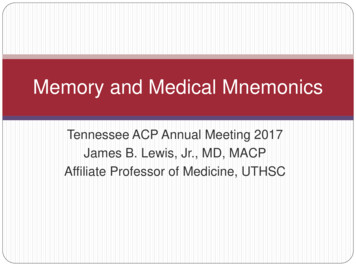
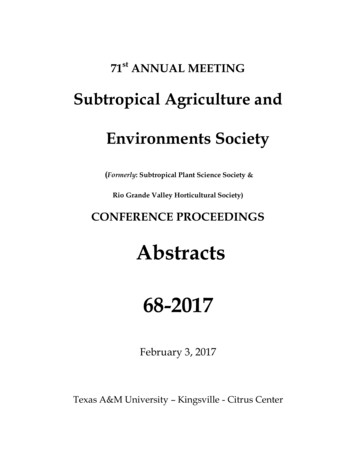
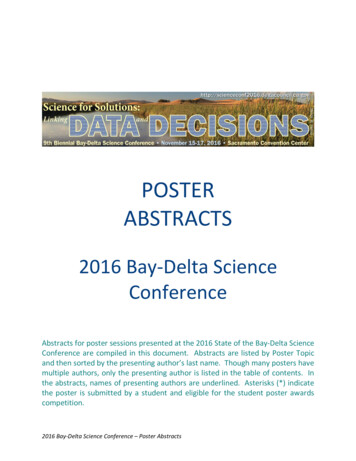

![[Facility Name] RESIDENT FOOD SURVEY](/img/4/resident-food-survey-template.jpg)
